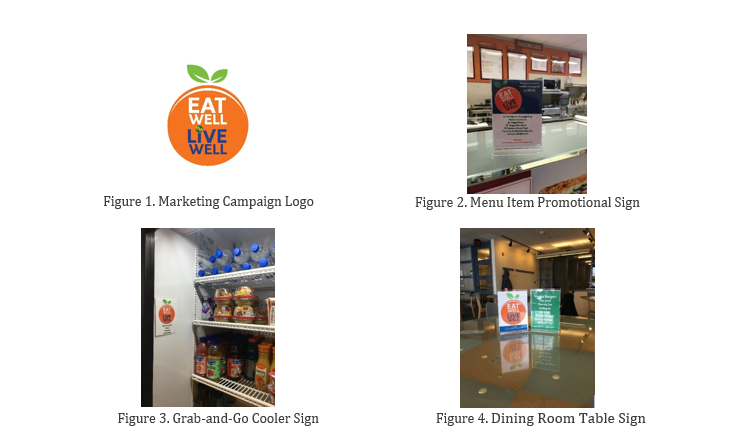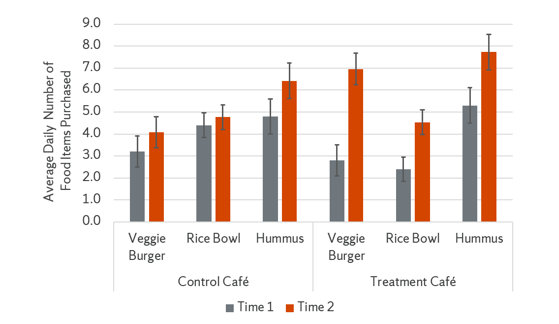Targeted Advertising Can Increase Healthy Food Choices Among College Students
April 30, 2019
Stephanie Spera
DOWNLOAD THE BREIF [PDF]
KEY FINDINGS
- The addition of healthy food marketing materials was associated with an increase in healthy food purchases among college students.
- The average daily purchase of veggie burgers increased by 4.2, rice bowls increased by 2.1, and hummus increased by 2.4 units.
- Total daily purchases of the three target items in the treatment café increased from an average of 10.5 daily before the intervention to an average of 19.2 daily after intervention.
Healthy Food Marketing Strategy at Syracuse University
Enhancing signage to include the energizing, sensory/taste, and time-efficient properties of healthy foods is an effective way to grab students’ attention and encourage them to make healthy choices.2-4 In January 2018, the Lerner Center for Public Health Promotion collaborated with the Maxwell X Lab and Food Services Program at Syracuse University on a study to determine whether healthy food marketing would increase the purchase of specific nutritious foods in one campus dining venue. The treatment café was compared to another dining venue on campus (the control café) that shares similar menu items, prices, and sales trends. We measured changes in the purchase of veggie burgers, rice bowls, and hummus snack packs in each café. Marketing materials in the treatment café included a logo for consistent branding (Figure 1), signage to promote the three selected menu items (Figure 2), signage on the grab-and-go cooler (Figure 3), and table signs throughout the dining room (Figure 4). Prices remained unchanged throughout the study. Sales data were collected for three weeks from both the treatment and control cafés prior to adding marketing materials. Marketing materials were added to the treatment café for four weeks. Figure 5 shows sales data on the three healthy food items for both the treatment café and the control café prior to and after the addition of marketing materials. The addition of marketing materials was related to a significant increase in the purchase of all three healthy foods in the treatment café.
Sales data were collected for three weeks from both the treatment and control cafés prior to adding marketing materials. Marketing materials were added to the treatment café for four weeks. Figure 5 shows sales data on the three healthy food items for both the treatment café and the control café prior to and after the addition of marketing materials. The addition of marketing materials was related to a significant increase in the purchase of all three healthy foods in the treatment café.
 Figure 5. Average Purchases of Healthy Food Items Increased Significantly in the Treatment Café
Note: error bars represent 95% confidence intervals
In the treatment café, the average daily purchase of veggie burgers increased by 4.2, rice bowls increased by 2.1, and hummus increased by 2.4 units. Total daily purchases of the three target items in the treatment café increased from an average of 10.5 before the intervention to an average of 19.2 after intervention. There were not significant increases in sales of the three healthy food items in the control café.
Figure 5. Average Purchases of Healthy Food Items Increased Significantly in the Treatment Café
Note: error bars represent 95% confidence intervals
In the treatment café, the average daily purchase of veggie burgers increased by 4.2, rice bowls increased by 2.1, and hummus increased by 2.4 units. Total daily purchases of the three target items in the treatment café increased from an average of 10.5 before the intervention to an average of 19.2 after intervention. There were not significant increases in sales of the three healthy food items in the control café.
Implications for College Campuses
Young adult dietary behaviors tend to be more convenience-driven than older age groups.5 For individuals who are more likely to eat on-the-go, such as students and other members of the campus community, improving visibility of healthy options through posters and appealing packaging can result in healthier purchasing behavior.3 In our experiment, visually-appealing food marketing was placed strategically to grab students’ attention before dietary decisions were made, which increased the likelihood that students would purchase a healthy meal or snack. Although we did not track changes in students’ eating habits over time, our findings suggest that our additional targeted marketing strategy may have increased sales of selected items during the marketing period. Shifting advertising and dining options to accommodate young adult needs are low-cost and scalable strategies that can be easily implemented at colleges and universities across the country. These strategies can be an effective way to improve dietary behaviors and help reduce the future social and economic burdens of chronic disease and premature mortality.References
- Wang, Y.C., McPherson, K., Marsh, T., Gortmaker, S. L., & Brown, M. (2011). Health and economic burden of the projected obesity trends in the USA and the UK. The Lancet 378, pp. 815-825.
- Marquis, M. (2005). Exploring convenience orientation as a food motivation for college students living in residence halls. International Journal of Consumer Studies 29(1), pp. 55-63.
- Buscher, L. A., Martin, K. A., & Crocker, S. (2001). Point-of-purchase messages framed in terms of cost, convenience, taste, and energy improve healthful snack selection in a college foodservice setting. Journal of the American Dietetic Association 101(8), pp. 909-913.
- Belaski, A. (2001): College and university students present a challenge for nutritionists. Journal of the American Dietetic Association 101(8), p. 913.
- Marquis, M. (2005). Exploring convenience orientation as a food motivation for college students living in residence halls. International Journal of Consumer Studies 29(1), pp. 55-63.